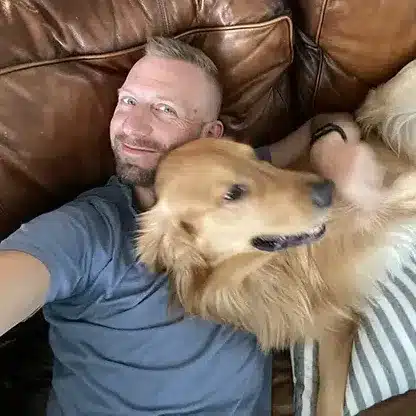Can Dogs Get Ingrown Hairs? Our 2025 Guide
Quick Guide
Ingrown hairs can be a pesky and painful condition that adults encounter, but can dogs get ingrown hairs too? Yes – even our furry friends are susceptible to hair follicles being trapped under their skin.
Though we may be more prone to them, dogs can undoubtedly get ingrown hairs too.
With that being said, the main culprit behind ingrown hairs in dogs is usually due to bad grooming habits. This can be anything from shaving too closely or even shaving against the grain.
Similarly, to humans, ingrown hairs in dogs can also be caused by dead skin cells. When these cells coat the hair follicle, it can cause the hair to grow sideways or even backwards into the skin. This then results in an inflamed, itchy bump.
Let’s dive a little deeper in…
What Are Ingrown Hairs?
These little annoyances of life are more formally known as pseudo folliculitis barbae. They occur when the hair shaft grows back into the skin instead of away from it.
Ingrown hairs in both dogs and humans are similar in nature. Both can be caused by shaving or clipping too close to the skin and result in swollen, red bumps.
They can also be incredibly itchy which can lead to your dog scratching and biting at their skin- further exacerbating the issue. In severe cases, they can even lead to infection.
What Causes Ingrown Hairs in Dogs?
Now that we understand what ingrown hairs are, let’s take a look at what causes them.
As noted earlier, the main cause of ingrown hairs in dogs is shaving or clipping too close to the skin. This can happen if you’re using a dull razor or if you’re not careful enough while grooming your pup.
Another cause is curly hair. Curly hair is more likely to grow back into the skin because it has a natural tendency to do so. This is why dogs with curly hair are more prone to ingrown hairs. Hello Poodle!
Folliculitis also known as, Superficial Bacterial Folliculitis is an inflammation or infection of the hair follicle, can also be a contributing factor.
Lastly, dead skin cells can also play a role in the development of ingrown hairs. When these cells accumulate, they can block the hair follicle and cause the hair to grow back into the skin.
Nonetheless, no matter what the cause, it’s important to take care of ingrown hairs as soon as possible to prevent further irritation and discomfort for your pup.
Which leads us perfectly into our next topic…
How to Prevent Ingrown Hairs in Dogs
Attempting to prevent these pesky annoyances will undoubtedly save you a lot of time, money, and stress in the long run. Here are a few tips on how to do so:
- Regularly brush your dog’s coat – This will help to remove any dead skin cells that could be blocking the hair follicle.
- Quality clippers for dog hair – This will help to avoid any irritation that could be caused by using a dull razor.
- Pay close attention to their toes – ASCPA notes, this is a common area for ingrown hairs to develop. Be sure to trim the hair around their toes regularly.
- Bathe, but don’t over-bathe – Washing your dog too often can actually strip their skin of its natural oils which can lead to dryness. This, in turn, can make their skin more susceptible to ingrown hairs.
Close attention and proper grooming techniques can go a long way in preventing ingrown hairs. However, even with the best care, they can still happen from time to time.
With that being said, it’s important to know how to properly treat doggie ingrown hairs
How to Treat Ingrown Hairs in Dogs
If your dog does unfortunately develop an ingrown hair, don’t fret!
If an ingrown hair appears of symptoms of itchiness, redness, or swelling, the first thing you’ll want to do is bathe them with a soothing shampoo. Doing so will help to remove any irritants that could be further aggravating the situation.
After they’re all clean, you’ll want to carefully trim the hair around the ingrown hair. This will help to release the trapped hair and allow it to grow out properly.
Authors at Wag Walking make note that, “Poulticing the area with cotton wool soaked in warm salt water may help.” It is believed that the warm salt water helps to draw out the ingrown hair.
If the ingrown hair is particularly bothersome or if there’s any discharge, you may need to seek professional help. In these cases, your veterinarian can prescribe antibiotics or other medication to help clear up the infection.
Frequently Asked Questions:
Can apple cider vinegar help folliculitis in dogs?
There is no scientific evidence to support the claim that apple cider vinegar can help with folliculitis in dogs. According to Dr. McCullough you should avoid using apple cider vinegar on your dog as it could further irritate their skin.
Can I try removing the ingrown hair?
It is not recommended that you try to remove the ingrown hair yourself as this could further irritate the skin and cause an infection. If you’re concerned, it’s always best to seek professional help.
Do ingrown hairs naturally fix themselves?
In some cases, yes. However, if the ingrown hair is particularly bothersome or there’s any discharge, you may need to seek professional help
Conclusion
Hopefully you found value in this article and feel more equipped to deal with ingrown hairs should your pup ever develop them. Ingrown hairs are a nuisance, but with the proper care and attention, they’re easy to take care of!











